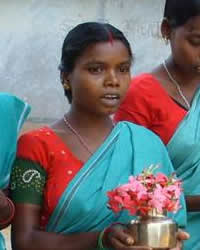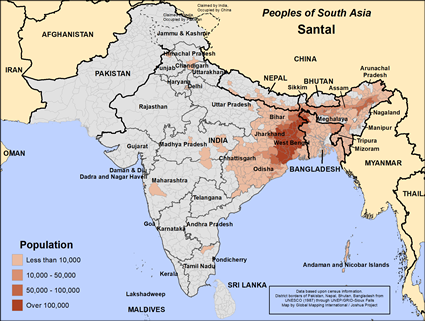The Santal are regarded as some of the earliest settlers of the Indian subcontinent. Most live in India, primarily occupying the states of West Bengal, Jharkhand, Bihar, Odisha and Assam. However, the Santal also possess significant presences in Bangladesh and Nepal. The Santals in Nepal speak Santali.
The original homeland and early history of the Santals is difficult to ascertain. While they possess rich oral traditions, they lack written records of their historical development. It is possible that Santals first moved to Nepal to avoid involvement in the Santal Rebellion of 1855, which came in response to their exploitation under British colonial rule. While their history is somewhat vague, the Santals have experienced many challenges, and challenges continue to mark Santal life today.
Many Santals live in poverty. It is common for Santals to work as day laborers, making low wages in tea gardens or in other capacities demanding physical labor. Agriculture plays a large role in their diets; main foods include rice, vegetables and fish. Jute leaves are a Santal favorite, as is rice beer. Delicacies include tortoise eggs and the eggs of various birds. Santals also eat crab, chicken, beef, pork, duck, goat and squirrel meat.
Santals are known for their love for singing, dancing and playing music. They host various festivals throughout the year, including Sohrai, where they express gratitude to their god of crops, and Baha, the blossoms festival. During the year, Santal women wear saris with flowers on their heads, while men wear loincloths called dhotis or gamchhas. Some well-educated or wealthy Santals wear more modern attire. Both men and women have tattoos.
Santal society is divided into 12 clans. These clans compose a hierarchy, and while people are typically born into their clans, one s clan is tied to his or her profession. One of these clans' roles is to enforce marriage and divorce rules. Historically, a man and a woman of the same clan could not marry, though this rule has been relaxed in contemporary times. When a man marries a woman, he pays a bride price to her father. Santal families are patriarchal, with fathers typically carrying primary decision making responsibility. Mothers often participate in income-generating activities or farm for the family.
Many Santals believe in over 150 spirit deities, known as bongas. There are multiple ranks of bongas. Benevolent ones are said to live in a village s sacred grove, with malevolent ones living in the forest or in other aspects of nature. There is a long process of rituals through which Santals believe deceased ancestors become bongas.
Traditional Santal religion also believes in the existence of a supreme deity called Marang Buru ( the Great Mountain ) or Thakur Jiu ( life-giver ). The highest-ranking bongos are closely associated with this creator deity. Isolated tribes may have less organized classification systems within an animistic worldview.
A village priest called a naeke performs religious acts pertaining to festivals, ceremonies, and sacrifices made to sacred grove bongas. A shaman called an ojha is responsible for preparing medicines from plants and driving away malevolent bongas. Many Santals believe in witchcraft, and it is common for people to accuse others of being involved in this. Santal religious beliefs can vary depending on the context.
Santals face numerous challenges. They live in extreme poverty and have limited access to education. Local communities have discriminated against them and exploited them, depriving them of land and other assets. Those in Nepal live in an area extremely vulnerable to natural disasters. Santals are resourceful and hardworking but live a very difficult lifestyle. Their greatest need is to know Christ and enjoy the forgiveness and reconciliation He provides.
Pray for the Lord to provide Santals with increased access to education and protection from those who would take advantage of them.
Pray for the Lord to send Christians to the Santals who would bear their burdens and share the gospel with them.
Pray for the Lord to soften the hearts of Santals to the gospel in India, Bangladesh and Nepal.
Pray for the Lord to sanctify believing Santals, guard them from error and equip them with godly discipleship.
Scripture Prayers for the Santal (Sawntal) in Nepal.
https://en.wikipedia.org/wiki/Santal_people
https://www.academia.edu/36247997/Santal_Community_in_Bangladesh_A_Socio_historical_Analysis
https://www.researchgate.net/publication/337166991_Santal_Community_in_Bangladesh_A_Socio-historical_Analysi
| Profile Source: Joshua Project |












